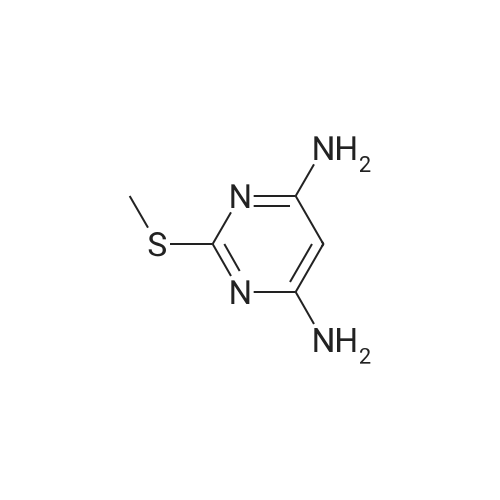Cat.NO.:A183548 Purity:97%
Product Details of [ 1005-39-6 ]
| CAS No. : | 1005-39-6 |
| Formula : |
C5H8N4S |
| M.W : |
156.21
|
| SMILES Code : | NC1=NC(SC)=NC(N)=C1 |
| MDL No. : | MFCD00023241 |
| InChI Key : | AHAIUNAIAHSWPG-UHFFFAOYSA-N |
| Pubchem ID : | 70497 |
Safety of [ 1005-39-6 ]
| GHS Pictogram: |  |
| Signal Word: | Warning |
| Hazard Statements: | H302-H315-H319-H335 |
| Precautionary Statements: | P261-P301+P312-P302+P352-P304+P340-P305+P351+P338 |
Computational Chemistry of [ 1005-39-6 ] Show Less
Physicochemical Properties
| Num. heavy atoms | 10 |
| Num. arom. heavy atoms | 6 |
| Fraction Csp3 | 0.2 |
| Num. rotatable bonds | 1 |
| Num. H-bond acceptors | 2.0 |
| Num. H-bond donors | 2.0 |
| Molar Refractivity | 42.56 |
| TPSA ?
Topological Polar Surface Area: Calculated from |
103.12 Ų |
Lipophilicity
| Log Po/w (iLOGP)?
iLOGP: in-house physics-based method implemented from |
1.15 |
| Log Po/w (XLOGP3)?
XLOGP3: Atomistic and knowledge-based method calculated by |
0.35 |
| Log Po/w (WLOGP)?
WLOGP: Atomistic method implemented from |
0.38 |
| Log Po/w (MLOGP)?
MLOGP: Topological method implemented from |
-0.22 |
| Log Po/w (SILICOS-IT)?
SILICOS-IT: Hybrid fragmental/topological method calculated by |
0.06 |
| Consensus Log Po/w?
Consensus Log Po/w: Average of all five predictions |
0.34 |
Water Solubility
| Log S (ESOL):?
ESOL: Topological method implemented from |
-1.41 |
| Solubility | 6.12 mg/ml ; 0.0392 mol/l |
| Class?
Solubility class: Log S scale |
Very soluble |
| Log S (Ali)?
Ali: Topological method implemented from |
-2.08 |
| Solubility | 1.3 mg/ml ; 0.00832 mol/l |
| Class?
Solubility class: Log S scale |
Soluble |
| Log S (SILICOS-IT)?
SILICOS-IT: Fragmental method calculated by |
-1.42 |
| Solubility | 5.97 mg/ml ; 0.0382 mol/l |
| Class?
Solubility class: Log S scale |
Soluble |
Pharmacokinetics
| GI absorption?
Gatrointestinal absorption: according to the white of the BOILED-Egg |
High |
| BBB permeant?
BBB permeation: according to the yolk of the BOILED-Egg |
No |
| P-gp substrate?
P-glycoprotein substrate: SVM model built on 1033 molecules (training set) |
No |
| CYP1A2 inhibitor?
Cytochrome P450 1A2 inhibitor: SVM model built on 9145 molecules (training set) |
No |
| CYP2C19 inhibitor?
Cytochrome P450 2C19 inhibitor: SVM model built on 9272 molecules (training set) |
No |
| CYP2C9 inhibitor?
Cytochrome P450 2C9 inhibitor: SVM model built on 5940 molecules (training set) |
No |
| CYP2D6 inhibitor?
Cytochrome P450 2D6 inhibitor: SVM model built on 3664 molecules (training set) |
No |
| CYP3A4 inhibitor?
Cytochrome P450 3A4 inhibitor: SVM model built on 7518 molecules (training set) |
No |
| Log Kp (skin permeation)?
Skin permeation: QSPR model implemented from |
-7.0 cm/s |
Druglikeness
| Lipinski?
Lipinski (Pfizer) filter: implemented from |
0.0 |
| Ghose?
Ghose filter: implemented from |
None |
| Veber?
Veber (GSK) filter: implemented from |
0.0 |
| Egan?
Egan (Pharmacia) filter: implemented from |
0.0 |
| Muegge?
Muegge (Bayer) filter: implemented from |
1.0 |
| Bioavailability Score?
Abbott Bioavailability Score: Probability of F > 10% in rat |
0.55 |
Medicinal Chemistry
| PAINS?
Pan Assay Interference Structures: implemented from |
0.0 alert |
| Brenk?
Structural Alert: implemented from |
0.0 alert: heavy_metal |
| Leadlikeness?
Leadlikeness: implemented from |
No; 1 violation:MW<1.0 |
| Synthetic accessibility?
Synthetic accessibility score: from 1 (very easy) to 10 (very difficult) |
1.95 |
Application In Synthesis of [ 1005-39-6 ]
* All experimental methods are cited from the reference, please refer to the original source for details. We do not guarantee the accuracy of the content in the reference.
- Downstream synthetic route of [ 1005-39-6 ]
[ 1005-39-6 ] Synthesis Path-Downstream 1~35
- 2
 [ 1005-39-6 ]
[ 1005-39-6 ]
 [ 58-86-6 ]
[ 58-86-6 ]
- tri-<i>O</i>-acetyl-<i>N</i>-(6-acetylamino-2-methylsulfanyl-pyrimidin-4-yl)-α-D-xylopyranosylamine [ No CAS ]

- tri-<i>O</i>-acetyl-<i>N</i>-(6-acetylamino-2-methylsulfanyl-pyrimidin-4-yl)-β-D-xylopyranosylamine [ No CAS ]
- 3
 [ 1005-39-6 ]
[ 1005-39-6 ]
 [ 58-86-6 ]
[ 58-86-6 ]
- <i>N</i>-(6-amino-2-methylsulfanyl-5-nitroso-pyrimidin-4-yl)-β-D-xylopyranosylamine [ No CAS ]
- 7
 [ 1005-39-6 ]
[ 1005-39-6 ]
 [ 3891-59-6 ]
[ 3891-59-6 ]
 [ 15470-55-0 ]
[ 15470-55-0 ]
- <i>O</i>2,<i>O</i>3,<i>O</i>4,<i>O</i>6-tetraacetyl-D-glucose-[6-amino-5-(2,5-dichloro-phenylazo)-2-methylsulfanyl-pyrimidin-4-ylimine] [ No CAS ]
- 8
 [ 1005-39-6 ]
[ 1005-39-6 ]
 [ 15470-55-0 ]
[ 15470-55-0 ]
- <i>O</i>2,<i>O</i>3,<i>O</i>4-Triacetyl-<i>O</i>5-benzyl-D-ribose [ No CAS ]

- <i>O</i>2,<i>O</i>3-diacetyl-<i>O</i>5-benzyl-D-ribose-[6-amino-5-(2,5-dichloro-phenylazo)-2-methylsulfanyl-pyrimidin-4-ylimine] [ No CAS ]
- 9
 [ 1005-39-6 ]
[ 1005-39-6 ]
 [ 15470-55-0 ]
[ 15470-55-0 ]
 [ 1195580-25-6 ]
[ 1195580-25-6 ]
- <i>O</i>5-benzoyl-D-ribose-[6-amino-5-(2,5-dichloro-phenylazo)-2-methylsulfanyl-pyrimidin-4-ylimine] [ No CAS ]
- 12
 [ 1005-39-6 ]
[ 1005-39-6 ]
 [ 108-24-7 ]
[ 108-24-7 ]
- <i>N</i>-(6-amino-2-methylsulfanyl-pyrimidin-4-yl)-acetamide [ No CAS ]
- 13
 [ 1005-39-6 ]
[ 1005-39-6 ]
 [ 75-36-5 ]
[ 75-36-5 ]
- <i>N</i>-(6-amino-2-methylsulfanyl-pyrimidin-4-yl)-acetamide [ No CAS ]
| Yield | Reaction Conditions | Operation in experiment |
|---|---|---|
| With NaNO2; In water monomer; glacial acetic acid; | Step 1) Synthesis of 4,5,6-triamino-2-methylthiopyrimidine To a solution of 245g of <strong>[1005-39-6]4,6-diamino-2-methylthiopyrimidine</strong> dissolved in 800 ml of acetic acid was added 250 ml of water. The reaction solution was cooled to 10C and thereto was added a solution of 119g of NaNO2 dissolved in 250 ml of water while maintaining the temperature at 10C. The reaction mixture was stirred at room temperature for 2 hours, filtered and dried to obtain 4,6-diamino-5-nitroso-2-methylthiopyrimidine, which was then dissolved in 1l of water. | |
| With glacial acetic acid; NaNO2; In water monomer; at 20℃; for 1.0h; | To a solution of 2-1 (2g, 12.80mmol, 1eq) in H2O (20mL) and AcOH (7.35g, 122.40mmol, 7.00mL, 9.56eq) was slowly added NaNO2 (1.77g, 25.61mmol, 2eq), the reaction solution was stirred at 20 C for 1 hour, the reaction solution was filtered, and the filter cake was dried under high vacuum to obtain compound 2-a. |












Reviews
There are no reviews yet.